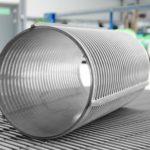The centrifugal pump is the most widely used pump for transferring fluids in a variety of industries, including food processing, dairy, drinks, pharmaceutical and cosmetics, winemaking, and others. Centrifugal and positive displacement pumps are the two primary types of pumps. Centrifugal pumps, in contrast to reciprocating pumps, are often designed for larger flows and lower viscosity liquids, down to 0.1 cP. The centrifugal pumps come in a variety of models, depending on the industrial requirement, application needs, and viscosity.

Applications
Centrifugal pumps are utilized in a variety of sectors and for a variety of purposes. They are similar to reverse water turbines. They work by moving an impeller, which converts rotational energy into kinetic energy and pushes water through a chamber or casing. Water enters the casing through an “eye,” where it is propelled through and out of the chamber by the impeller.
Horizontal and Vertical Centrifugal pump are used in a wide range of industries. Some of their industrial applications are given below
- They’re commonly seen in refineries and power plants.
- They’re also the preferred pump for municipal water systems.
- When only a little amount of suction lift is required, they are utilized to move the general water supply from the pressure main.
- They can also be utilized for boiler feed, wastewater control, and flood prevention, and irrigation.
- Centrifugal pumps are also used in the construction industry. They are used to provide home-based booster service. They’re also utilized in sprinkler systems for fire protection and to circulate hot water. They can also be utilized for air conditioning and drainage.
- Centrifugal pumps are used as froth pumps in the mining sector to separate bitumen and minerals from clay and sand. They can also move solids and slurries with them.
- Oil, muck, slurry, and power generation plants are all pumped with these pumps in the oil and energy industries.
- These pumps are utilized in ventilation and heating, boiler feed, pressure boosting, fire security sprinkler systems, and air conditioning in industrial and fire protection applications.
- These pumps are used in wastewater treatment plants, gas processing, irrigation, drainage, municipal industry, and overflow protection in waste management, agriculture, and manufacturing.
- For hydrocarbons, paints, cellulose, petrochemical, beverage production, sugar refining, and food, these pumps are employed in the food, chemical, and pharmaceutical industries.
Limitations
The efficient operation of a centrifugal pump is dependent on the impeller rotating at a constant high speed. Centrifugal pumps become progressively inefficient with high viscosity feeds: there is more resistance and higher pressure is required to maintain a specific flow rate. These pumps are best suited to pumping liquids with viscosities ranging from 0.1 to 200 cP at low pressures and high capacities.
Slurries like mud or lubricants with a high viscosity can cause excessive wear and overheating, resulting in damage and premature failure. Positive displacement pumps, on the other hand, often operate at much slower speeds and are less prone to these issues.
The rapid speed of a centrifugal pumps impeller can damage any pumped medium that is sensitive to shearing (such as emulsions, slurries, or biological liquids). In such instances, a positive displacement pump with a lower speed is desirable.
Another disadvantage is that, unlike a positive displacement pump, a centrifugal pump cannot create suction while it is dry; it must be primed with the pushed fluid first. As a result, centrifugal pumps are unsuitable for any application where the supply is intermittent.
A centrifugal pump will also provide a varied flow if the feed pressure changes; a positive displacement pump, on the other hand, is insensitive to change pressures and will offer constant output. A positive displacement pump is preferred in applications where precise dosing is required.
Most low pressure, high capacity pumping applications involving low viscosity fluids such as water, solvents, chemicals, and light oils may be solved with centrifugal pump designs. Water supply and circulation, irrigation, and chemical transfer in petrochemical facilities are examples of typical applications.
Positive displacement pumps are favored for applications requiring very viscous fluids like thick oils and slurries, especially at high pressures, for complicated feeds like emulsions, edibles, or biological fluids, and when precise dosing is required.
Price pump specializes in addressing the needs of specialty applications for industries & OEM users. For quality centrifugal and MSW Pumps, visit www.pricepump.com/




